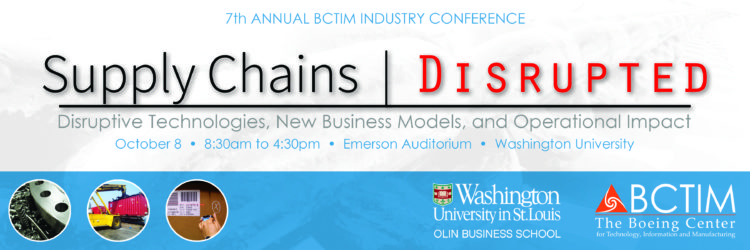The Boeing Center for Supply Chain Innovation presents…an interview with Professor Panos Kouvelis, Emerson Distinguished Professor of Operations and Manufacturing Management and Director of The Boeing Center for Supply Chain Innovation at Washington University in St. Louis, about the Global Supply Chain Benchmark Study, a collaborative research initiative of faculty at leading business schools including Olin. Below is an excerpt of the report; for the complete report, go here → http://bit.ly/GSCBS2016
BACKGROUND
“For the past 25 years manufacturing offshoring to low-cost locations like China has been the dominant strategy for many western manufacturing companies. This has led to a significant reduction of manufacturing jobs in developed economies. Recently, many manufacturers have reported they plan to bring back at least a part of their global production volume to developed countries. General Electric, for example, announced in 2012 they would relocate manufacturing and R&D of their household appliances business, which had previously been offshored to China and Mexico, to Louisville, KY in the USA.1 Similarly, Plantronics, a U.S. based manufacturer of headphones, shifted production volume back from China to Mexico.2 At the same time companies from perceived low-cost countries have reported investments in manufacturing capacity in developed economies. For instance, the Chinese company Lenovo recently brought back the production of personal computers to North America.
While there seems to be an emerging trend to reshore production, traditional offshoring to developing economies continues to be a viable phenomenon. For example, General Motors recently announced a USD 12bn investment in new plants in China.4 These examples offer just a glimpse of the magnitude of manufacturing location decisions companies are currently making in a wave of restructuring of their global supply chains.”
EXECUTIVE SUMMARY
“Despite the growing attention in the business press to reports of companies relocating manufacturing to western countries, there is very little empirical research on the scale of such decisions, their drivers and their impact. Hence, in this study we investigate current trends in production sourcing. Based on a survey of 74 leading manufacturing companies predominantly from North America, Europe and Japan we shed some light on (1) what production sourcing decisions are currently being made, (2) what drives these decisions and (3) what results do they lead to.
Our research suggests that there is a significant wave of restructuring of global supply chains in progress. Companies de- and increase production volume all over the globe as shown in the overview presented in Exhibit 1. However, we did not observe a dominant strategy for sourcing production volume. Companies make different decisions for a variety of reasons. While China continues to be the most attractive country for manufacturing, many companies reported following (also) other strategies. Moreover, we see that decision making has evolved from simple cost comparisons to more complex trade-offs between a magnitude of factors that are deemed important, i.e., across quality, market access and risk. Based on these and other reported drivers we see a shift of production not only to China but also to Eastern Europe and the ASEAN countries which are being used as nearshore sources of production for Western European and Chinese markets respectively.
For North America we see evidence for a return of manufacturing. It is not a strong trend but in our sample more companies report shifting production volume to North America rather than offshoring to other countries. This pattern is not consistent with the much cited reshoring trend predicted by many business and political commentators. The movement we observed is not driven by the reshoring of American firms but rather by European and Asian firms offshoring who account for 60% of the production volume increase in North America. While this is good news for manufacturing in North America, the indicators for the future of manufacturing in Western Europe appear to be less bright. Indeed, Western Europe is one of only two regions for which our sample reports a net decrease of production volume. Companies reported offshoring for a variety of reasons including shifting to either less costly locations or to places closer to market demand.
Despite the decline in production volume in certain regions, there is no evidence for a further decline in manufacturing jobs. In fact our sample reports that for China, Western and Eastern Europe their sourcing decisions hardly impacted employment. Moreover, it was only for North America and Japan that growth of manufacturing employment is observed.
We believe the analyses and insights presented in this research not only inform but also call for action. Executives should look at their supply chains critically by challenging their current footprint and production sourcing choices. We explicitly encourage benchmarking against the companies in our sample within their industry and across industries. Insights into market expectations and the forces driving the reported production sourcing and technology decisions should stimulate a discussion about future strategic actions.
For policy makers – especially in Western (European) countries – this research provides information concerning the perceived attractiveness of regions worldwide. Reading the report will provide policy makers with data about the trends in industry and the factors that have led companies to shift production into or away from particular regions and can thus inform the debate on how manufacturing policy can boost competitiveness, attract and retain manufacturing jobs.”
For the complete report, go here → http://bit.ly/GSCBS2016




 Throughout the day, the angles of the shadows outside grew shorter, and then longer again, as theoretical and practical knowledge was transmitted between supply chain practitioners. After a warm welcome address from Prof. Panos Kouvelis, the director of BCTIM, the attendees settled in for what would be a full day.
Throughout the day, the angles of the shadows outside grew shorter, and then longer again, as theoretical and practical knowledge was transmitted between supply chain practitioners. After a warm welcome address from Prof. Panos Kouvelis, the director of BCTIM, the attendees settled in for what would be a full day.












